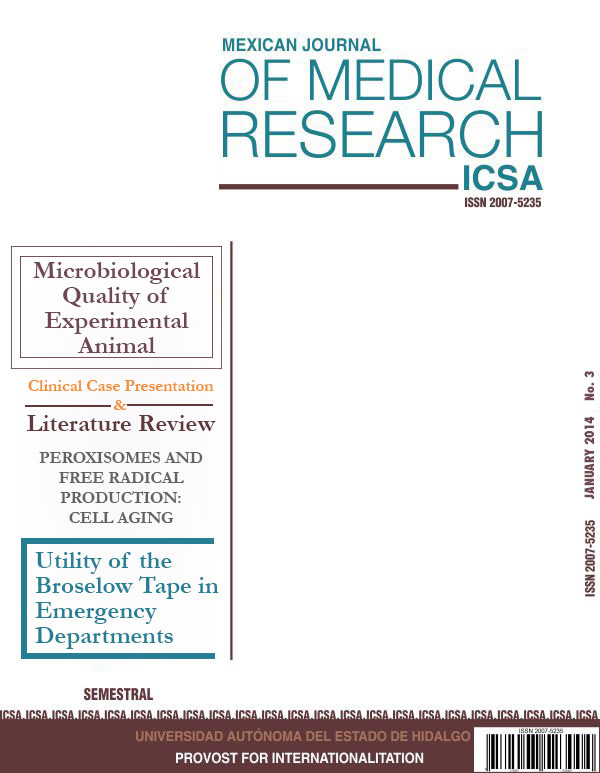Microbiological quality of experimental animal
DOI:
https://doi.org/10.29057/mjmr.v2i3.1798Keywords:
Laboratory animal, microbial status, health monitoring, recommendationsAbstract
Nowadays, it is unquestionable the importance of the laboratory animal health in research. Improving the microbial quality animal allows to reduce (or eliminate) the negative effects of pathogen agents (not associated with the objective of the study) in the expected experimental results. Health monitoring programs are used as preventive tools in animal facilities, although, in some circumstances many facilities cannot or have problems for establishing appropriate strategies. The present text attempts to bring the reader's interest to the laboratory animal health. A better awareness about this topic will allow a better use of animals in research.
Downloads
Publication Facts
Reviewer profiles N/A
Author statements
- Academic society
- N/A
- Publisher
- Universidad Autónoma del Estado de Hidalgo
References
2 . Nicklas W, Homberger FR, Illgen-Wilcke B, Jacobi K, Kraft V, Kunstyr I, Maehler M, Meyer H, Pohlmeyer-Esch G. Implications of infectious agents on results of animal experiments. Lab Anim 1999, 33: 39:87.
3 . Owens WE, Berg RD. Derivation of a breeding colony of germ-free athymic mice by cesarean section and foster nursing. J Immunol Methods 1981, 42 :115-9.
4 . Rülicke T, Montagutelli X, Pintado B, Thon R, Hedrich HJ. FELASA guidelines for the production and nomenclature of transgenic rodents. Lab Anim 2007, 41:301-11.
5 . Kraft V, Blanchet health monitoring, Boot R, Deeny A, Hansen AK, Hem A, van Herck H, Kunstyr I, Needham JR, Nicklas W, Perrot A, Rehbinder C, Richard Y, de Vroey G. Recommendations for health monitoring of mouse, rat, hamster, guineapig, and rabbit breeding colonies. Report of the Federation of European Laboratory Animal Science Associations (FELASA) Working Group on Animal Health accepted by the FELASA Board of Management November 1992. Lab Anim 1994, 28:1–12.
6 . Rehbinder C, Baneux P, Forbes D, van Herck H, Nicklas W, Rugaya Z, Winkler G. FELASA recommendations for the health monitoring of breeding colonies and experimental units of cats, dogs, and pigs. Report of the Federation of European Laboratory Animal Science Associations Working Group on Animal Health. Lab Anim 1998, 32:1–17.
7 . Rehbinder C, lenius S, Bures J, de las Heras ML, Greko C, Kroon PS, Gutzwiller A. FELASA recommendations for the health monitoring of experimental units of calves, sheep, and goats. Report of the Federation of European Laboratory Animal Science Associations (FELASA) Working Group on Animal Health. Lab Anim 2000, 34:329–350.
8 . Nicklas W, Baneux P, Boot R, Decelle T, Deeny A, Fumanelli M, Illgen-Wilcke B. Recommendations for the health monitoring of rodent and rabbit colonies in breeding and experimental units. Recommendations of the Federation of European Laboratory Animal Science Associations (FELASA) Working Group on Health Monitoring of Rodent and Rabbit Colonies accepted by the FELASA Board of Management, 9 June 2001. Lab Anim 2002, 36:20–42.
9 . ICLAS (International Council for Laboratory Animal Science). Performance Evaluation Program for Diagnostic Laboratories (PEP). ICLAS Network for Promotion of Animal Quality in Research. 2007. Available online at http://www.iclas.org/NetworkPEP.htm
10 . Guillen J. FELASA guidelines and recommendations. J Am Assoc Lab Anim Sci. 2012, 51:311-21.
11 . Nicklas W. International harmonization of health monitoring. ILAR J. 2008; 49(3):338-46.






















